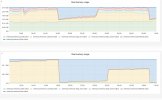Hi,
As you can see on that stats.
One of my servers hit its maximum memory capacity in less than 6 hours.
So I have to clean memory if I don't want to see all my websites getting slow like the hell.
Any solution to resolve this permanently?
As you can see on that stats.
One of my servers hit its maximum memory capacity in less than 6 hours.
So I have to clean memory if I don't want to see all my websites getting slow like the hell.
Bash:
$ sync; echo 3 > /proc/sys/vm/drop_caches
$ swapoff -a
$ swapon -aAny solution to resolve this permanently?

